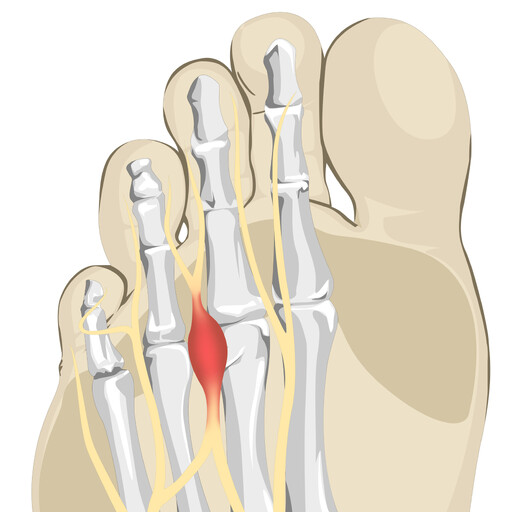Neuromas
A traumatic neuroma is a painful condition, also referred to as a “pinched nerve” or a benign nerve tumour. It is a benign growth of nerve tissue frequently found between the third and fourth toes metatarsal heads. It is not a “true” Neuroma in the sense that it does not involve a general nerve cellular change with the effected nerve but rather a fibrous type sheath that surrounds the nerve.
In general terms it is also appropriate to call all of them “Traumatic Inter-Metatarsal Neuromas” as they are all caused by mechanical trauma and they all tend to originate from, or under, the Inter-Metatarsal spaces.
The nerve that is commonly affected is the third communicating branch of the medial and lateral plantar nerve of the forefoot. This nerve supplies the 3rd and 4th toes and their intervening web space and when this nerve is affected we name the Neuroma a “Morton’s Neuroma”.
Signs & Symptoms
Neuromas can cause pain, a burning sensation, tingling, or numbness between the toes and in the ball of the foot.
The principal symptom associated with a neuroma is pain between the toes while walking. Those suffering from the condition often find relief by stopping their walking, taking off their shoe, and rubbing the affected area. At times, the patient will describe the pain as similar to having a stone in his or her shoe. The vast majority of people who develop neuromas are women.
Other symptoms of a neuroma include:
feeling that you are "walking on a marble,"
Pain in the forefoot and between the toes
Tingling and numbness in the ball of the foot
Swelling between the toes
Pain in the ball of the foot when weight is placed on it
Irritation and pain particularly in high-heeled shoes
Irritation and pain particularly in tight, narrow shoes, compressing the toe bones and pinching the nerve
Causes
Although the exact cause for this condition is unclear, at a cellular level we understand that this nerve sheath thickening is a direct physiological response to abnormal compression and shear stress that pushes onto the nerve from the surrounding metatarsal heads, which for various reasons, squeeze against it.
A number of factors can contribute to the formation of a neuroma:
Biomechanical deformities, such as a high-arched foot or a flat foot, can lead to the formation of a neuroma. These foot types bring on instability and increased point loading around the toe joints, leading to the development of the condition.
Foot types where the inside portion (medial column) moves excessively up and down against the outsdie portion of the foot (lateral column) can cause excessive tissue stress where they glide. It's now understood Morton's neuroma form in this location.
Trauma can cause damage to the nerve, resulting in inflammation or swelling of the nerve.
Improper footwear that causes the toes to be squeezed together is problematic. Avoid high-heeled shoes higher than 6cm. Shoes at this height can increase pressure on the forefoot area.
Repeated stress, common to many occupations, can create or aggravate a neuroma.
Tightness in the calf muscle resulting in increased fore-foot pressure during weight-bearing
Change in occupation, moving from a sedentary to active or vice versa can produce an increase in weight-bearing activity or change in footwear
Pregnancy, increased body weight, increased forefoot joint instability due to general normal related ligamental laxity
Diagnosis
Our podiatrist will examine and likely utilise ultrasonic investigation or may refer for an MRI investigation of the affected area and suggest a treatment plan that best suits your individual case.
Treatment
Treatment options vary with the severity of each neuroma.
For simple, undeveloped neuromas, a pair of thick-soled shoes with a wide toe box is often adequate treatment to relieve symptoms, allowing the condition to diminish on its own.
Padding and Taping: Special padding at the ball of the foot may change abnormal foot function and relieve the symptoms caused by the neuroma.
Medication: Anti-inflammatory drugs and cortisone injections can be used to ease acute pain and inflammation caused by the neuroma, however, may not offer long-term relief. You will need to consult our podiatrist or your GP before using medication.
Orthotics: Prescription orthotics can help control your foot movement and can be a useful treatment to provide long-term relief from a painful neuroma. Prescription orthotics can also prevent painful neuromas from growing. This helps to avoid further treatment.
Surgical treatment is only recommended when all non-invasive options have failed or are unlikely to help.
Home Treatment
What can you do for relief?
Wear shoes with plenty of room for the toes to move, low heels, and laces or buckles that allow for width adjustment.
Wear shoes with thick, shock-absorbent soles, as well as proper insoles that are designed to keep excessive pressure off of the foot.
High-heeled shoes with a rear foot to forefoot height difference of over 6cm should be avoided whenever possible because they place undue strain on the forefoot.
Resting the foot and massaging the affected area can temporarily alleviate neuroma pain. Use an ice pack to help to dull the pain and improve comfort.
Use over-the-counter shoe pads. These pads can relieve pressure around the affected area, however often fail to offer relief as they are not specifically designed to fit the unique shape of your foot and precisely remove the pressure from the affected area.
Prevention
Although the exact causes of neuromas are not completely known, the following preventive steps may help:
Make sure your exercise shoes have enough room in the front part of the shoe and that your toes are not excessively compressed.
Wear shoes with adequate support and padding in the ball of the foot (not too soft as this can increase any abnormal foot movement).
Avoid prolonged time in shoes with a narrow toe box or excessive rear foot to forefoot height difference greater than 6cm.

